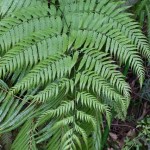Species: Cibotium barometz
English name: Lamb of Tartary/Golden Chiken fern/Wolly fern
Chinese name: 金毛狗、黃毛狗、黃狗頭
Family: Dicksoniaceae.
Description:
Perennial, large fern (grows to a height of 1m). Rhizomes are stout, creeping in the soil, covered with dense golden-yellow hairs. Fronds are large, tripinnate. It can be found on bank of dicthes, under woods, in damp and shady places.
Preparation: Rhizome and golden hairs are used. Collected all year round. The rhizome should be clear of its golden hairs and fibrous roots, sliced, steamed and dried for storage. Golden hair should be dried for use or ground into power.
Properties: Bitter, sweet in taste, warm in nature.
Actions and Indications: Invigorating liver and kidney, strengthening tendon and bone, expelling wind and damp. Indicated for lumbar muscle strain, pain in a waist and lower extremities, rheumatic arthralgia, hemiplegia, polyuria, etc. Golden hair can be used to relieve wound bleeding.

References:
– Department of Gardens and Green Areas, Civic and Municipal Affairs Bureau of Macao Special Administrative Region, South China Botanical Garden, Chinese Academy of Science 2005. Flora of Macao (Volume 1). Macao, SAR: Author

